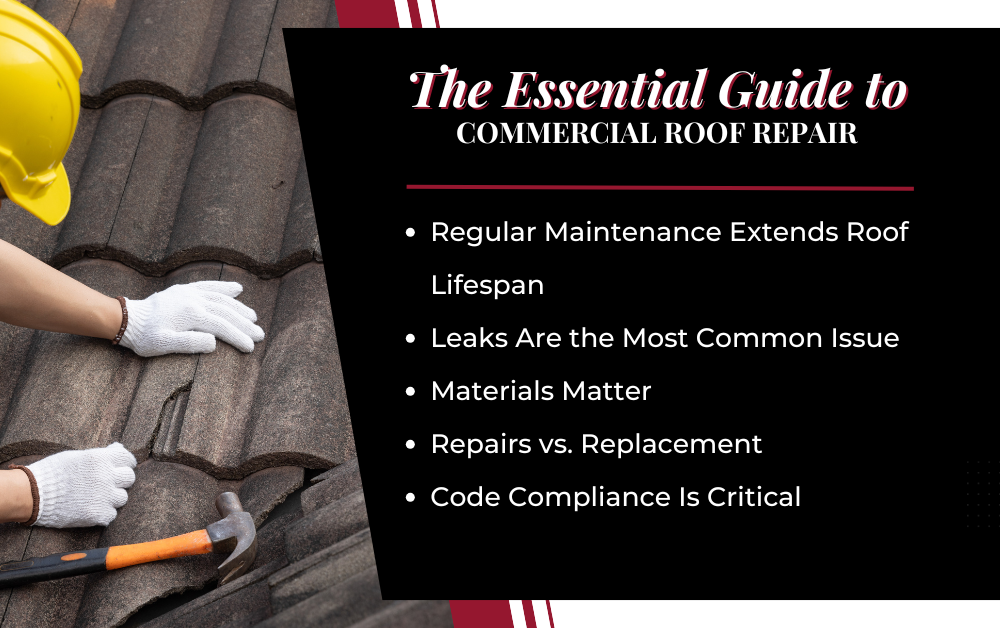Commercial roofing systems are built to endure heavy use and harsh weather conditions, but they aren’t indestructible. Over time, even the best-installed roofs will require attention. That’s why understanding how to care for, repair, and replace commercial roofs is critical for property owners and facility managers. Allocating resources toward roof maintenance and repairs often results in helping to prevent business disruptions and expensive structural damage. Whether you’re dealing with a small leak or considering a full replacement, learning the key components of commercial roof repair is essential. At Dependable Roofing, we specialize in providing expert roof condition assessments and routine maintenance to ensure the long-term health and reliability of your commercial roofing system.
Regular Maintenance Extends Roof Lifespan
Routine maintenance is one of the most important—and often overlooked—factors that influence how long a commercial roof lasts. Property owners who schedule regular inspections and make timely repairs often find that their roofs outperform expected lifespans. This preventive approach helps avoid major structural issues, budget surprises, and unplanned downtime due to leaks or damage. Keeping a maintenance schedule can transform your roof from a reactive liability into a well-managed asset.
Maintenance Improves Longevity
Commercial roofs can last 20 to 40 years, depending on the material, climate, and how well they’re maintained. Regular inspections, cleaning, and minor repairs help prevent small issues from becoming larger problems. Over time, this proactive care reduces the likelihood of major structural damage. Maintenance doesn’t just extend the life of your roof—it also protects your investment in the building itself. Business owners who maintain their roofs properly often avoid costly emergency repairs and insurance complications.
Inspections Catch Problems Early
Seasonal roof inspections by trained professionals are key to detecting hidden damage. Issues like small punctures, deteriorating flashing, or clogged drainage systems may not be visible from the ground. However, left unaddressed, these minor problems can evolve into costly repair jobs. Inspection teams often turn to instruments such as moisture meters and infrared cameras to find problem areas early. Identifying and repairing damage before it spreads saves both time and money.
Budgeting Becomes Predictable
When you invest in a maintenance plan, you gain a clearer picture of future repair costs. Predictable inspections and small repairs allow you to budget more accurately over time. This approach avoids surprise expenses and keeps your operations running smoothly. It also helps prioritize future upgrades without scrambling for emergency funds. Ultimately, good maintenance planning turns commercial roof repair into a manageable part of your facility strategy.
Leaks Are the Most Common Issue
Leaks are the number one cause of emergency commercial roof repair. They often stem from poor drainage, material wear, or weather damage, especially on flat roofs. If not addressed quickly, even minor leaks can evolve into widespread problems that threaten building systems and inventory. Understanding why leaks happen and how to detect them early is critical for protecting your building and maintaining productivity.
Flat Roofs Invite Water Problems
Commercial properties are typically designed with flat or gently sloped roofs, making them particularly susceptible to water pooling. When water collects on a roof without proper drainage, it increases the risk of leaks and water infiltration. Over time, standing water can degrade roofing materials, damage insulation, and lead to interior mold. This makes addressing pooling and drainage issues a top priority for facility managers. Leaks are often a sign that water has been accumulating unnoticed for some time.
Leaks Lead to Bigger Issues
Even small leaks can cause major problems if they’re not fixed promptly. Water intrusion can damage the structure, electrical systems, and interior finishes of a building. Unchecked moisture can quickly lead to mold and mildew infestations, which can create health risks for occupants. Over time, untreated leaks may compromise the roof deck and lead to structural instability. That’s why quick action is essential when any signs of leakage are discovered.
Detection Tools Make a Difference
Professionals use a range of tools to find the source of leaks quickly and accurately. Thermal imaging, moisture sensors, and even drone inspections can help pinpoint problem areas without invasive work. These tools allow roofing contractors to address the issue without unnecessary tearing or guesswork. Early and precise detection minimizes repair costs and disruption to building occupants. It also ensures that the repair method is targeted and effective.
Materials Matter
Not all commercial roofs are created equal, and the material used plays a critical role in how repairs should be performed. Each roofing system—whether it’s made of rubber, thermoplastics, or asphalt-based materials—has its own repair protocols and compatibility requirements. Choosing the wrong repair approach can cause more damage and potentially void warranties. It’s crucial to work with experienced contractors who understand the specific materials used in your roof.
Each Roofing Type Is Unique
Commercial roofs are built with a variety of materials, including TPO, EPDM, PVC, and modified bitumen. Each material has distinct physical properties and repair needs. For instance, EPDM is rubber-based and repaired with adhesives, while TPO often requires heat-welded seams. Using the wrong repair method can degrade the material or create future vulnerabilities. Knowing your roof’s composition is the first step to making the right repair decisions.
Wrong Repairs Can Void Warranties
Manufacturers provide warranties on roofing materials, but they often come with strict repair guidelines. If an unqualified contractor uses the wrong tools or products, the warranty may be void. That could leave the building owner responsible for future issues that would have otherwise been covered. Using an experienced, certified contractor familiar with your roof’s material ensures your warranty remains intact. It also gives you peace of mind knowing the work meets manufacturer standards.
Matching Repair Materials Is Crucial
When repairing commercial roofs, it’s important to match the new materials precisely with the existing system. Incompatible patches or sealants can cause adhesion issues or material breakdown over time. Seam failures or blistering may result from improper matches. Professional roofers know how to source compatible materials and install them properly. This not only ensures the repair lasts but also maintains the roof’s structural integrity.
Repairs vs. Replacement
At some point, every property owner faces the decision of whether to repair or replace a commercial roof. While many issues can be resolved with targeted fixes, others require a more comprehensive solution. Once a roof reaches the limit of its durability, replacing it entirely may be unavoidable, especially if it has widespread damage. Knowing how to make the right call requires a detailed inspection and expert analysis.
Localized Repairs Save Money
Not every roof issue demands a full replacement. Often, small problems like punctures, seam separations, or flashing failures can be repaired affordably. These targeted repairs restore function without the downtime and cost of a total overhaul. Building owners should consult a roofing professional to assess whether the issue is isolated or more widespread. Choosing repair over replacement when appropriate can extend the roof’s life for several more years.
Full Replacement Has Long-Term Value
When a roof has widespread damage or has reached the end of its lifespan, replacement may be more cost-effective. Replacing the roof allows for better energy efficiency, improved insulation, and modern waterproofing systems. Although the upfront investment is higher, the long-term benefits include fewer future repairs and lower operating costs. In some cases, replacement may also be necessary to meet updated building codes. Knowing when to replace is just as important as knowing when to repair.
Inspection Drives the Decision
A thorough inspection is critical before choosing between repair and replacement. Roofers use techniques like core sampling, thermal imaging, and infrared scanning to assess the condition of the roofing system. This process helps determine whether water has compromised the insulation or structural deck. A data-driven approach ensures the final recommendation aligns with the roof’s actual condition. Armed with this information, building owners can make smarter, more cost-effective choices.
Code Compliance Is Critical
Beyond structural integrity and weatherproofing, every commercial roof repair must meet strict code requirements. Local building authorities set regulations that govern everything from drainage systems to fire safety. If your repairs aren’t up to code, you could face costly fines, liability issues, and delays in occupancy or resale. Working with licensed contractors helps avoid these risks and ensures the job is done right.
Building Codes Protect Safety
Every commercial roof repair must meet strict building codes set by local authorities, created to ensure the safety of both property and occupants. These codes regulate things like fire resistance, wind uplift ratings, and drainage systems. Ignoring them can lead to fines, failed inspections, or even forced shutdowns. Following code compliance helps preserve the validity of your insurance for any future claims. Following legal standards isn’t optional—it’s an essential part of commercial roof repair.
Energy and Environmental Standards Matter
Today’s building codes often include energy efficiency and sustainability requirements. This may involve using reflective roofing materials, improving insulation, or installing proper drainage systems. Non-compliant repairs could result in energy inefficiency, higher utility bills, or code violations. Contractors must stay up to date with evolving standards to avoid costly mistakes. Working with a knowledgeable team ensures your roof remains both compliant and efficient.
Always Hire Licensed Contractors
One of the best ways to ensure compliance is by hiring licensed and certified roofing professionals. These contractors are trained to understand local regulations and adhere to best practices in every repair. Licensed roofers are also more likely to carry proper insurance, protecting building owners from liability. A reputable contractor will also provide documentation of the work for future audits or real estate transactions. Ultimately, the right contractor ensures that commercial roof repair is done legally, safely, and correctly.
Conclusion
Commercial roof repair is a key aspect of preserving the value and function of any business property. Through routine maintenance, early leak detection, material-specific solutions, and proper code compliance, property owners can avoid costly disruptions and extend the life of their roofs. Making informed decisions about repairs versus replacements ensures long-term performance and investment protection. In a world of unpredictable weather and evolving building codes, working with skilled professionals is more important than ever. Don’t wait until a minor problem becomes a major one—take action today.
Need expert help with your commercial roof repair? Contact Dependable Roofing for a free quote and get your roof back in top shape.




